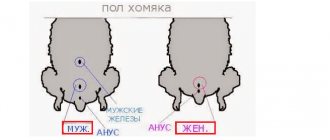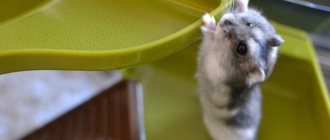Size
In nature, in their natural habitat, hamsters of all breeds are extremely active and energetic, because their life directly depends on the ability to run quickly: they need to go scouting for new food, collect it and take it to their burrow, simultaneously escaping from a predator.
Pets do not need to do all this, but nature takes its toll and requires that energy be spent moving around the cage; accordingly, the rodent should have enough space for this. In addition, he will need separate areas for toileting, eating, sleeping and storing supplies.
The recommended cage size for keeping one individual is 30x30x45, but more is possible. If you are limited in space, you can take a closer look at two-story options, but young and active animals often fall from the second floor, which can lead to injury.
What does a hamster need in a cage?
A large cage allows you not only to organize free space for the hamster to live, but also makes it possible to place many additional attributes and accessories in it.
Sleeping house
Many hamsters prefer to spend time, sleep and store their food supplies in secluded places. For these purposes, you can install small decorative plastic or wooden houses in the cage. Mandatory elements of the house should be a strong roof and a wide entrance. The presence of windows is not necessary, as animals can get stuck in them.
In terms of dimensions, the structure should be quite spacious so that pets can store food supplies in it. Instead of a house, you can use flexible bridges, which are installed in a cage and lightly covered with sawdust. You can make a sleeping place yourself, using, for example, a dried empty coconut, in which holes are made for entry.
Feeder and drinker
Feeders and drinkers are considered mandatory attributes of the cage. Feeders are placed at a height convenient for the pet. The food bowl should be small so as not to take up much space, and quite roomy, with sides of about 1.5 cm.
Design
This aspect can be divided into three additional ones.
Possibility of disassembly
You will have to clean the cage at least a couple of times a week, so the more convenient it is, the better. The ideal option is detachable models, which allow you to literally “unfasten” the grille from the pallet with one movement and gain convenient access inside.
Aquariums, which are also used by some owners to keep rodents, perform the worst in this regard. Looking ahead, it is worth noting that the aquarium was not originally intended and is poorly suited for a comfortable life for hamsters.
What should the pallet be like?
A cage for a dwarf should have a deep tray - the deeper it is, the better, especially if you are going to breed rodents.
Children are mobile from the first days of life and if the tray is low, they can fall out of their home. Deep trays are convenient for owners: less debris will fly out during active games.
Alternatively, you can purchase a cage with transparent plastic sides. Such a cage will definitely eliminate the need for additional cleaning around the cage.
The disadvantages of this type are:
- difficulty in hanging various accessories;
- restriction of the hamster's activity, since he cannot climb up and down the walls as in a cage with bars.
This type of cage can be equipped with external tunnels. By purchasing additional tunnels, you can connect another cage or additional module.
You can purchase models with drawers in pet stores. They are convenient for caring for parrots and canaries, but are pointless for dwarf parrots. Hamsters choose one corner for the toilet, so the liquid will leak and become a source of unpleasant odors, since there is no filler behind the pull-out shelf to absorb the odor.
Top part
The lattice can consist of cells of different sizes. In plastic cages they are usually smaller, which negatively affects ventilation, and the odor accumulated inside from waste products and gradually deteriorating supplies can adversely affect the health of the animal.
The metal mesh is larger, which provides good air movement, but gives some small breeds (for example, Djungarian hamsters) the opportunity to escape.
The aquarium is the most reliable in this regard, but there is practically no ventilation in it.
How to make a cage for Djungarian hamsters with your own hands
If the purchased version of the cage is not suitable, you can try to make it yourself. However, having made such a decision, you should take into account that an ordinary jar, an old aquarium or a cardboard box will not be suitable for your future home.
Tools and materials
In the process of making a homemade cage for a dzhungarika you will need the following tools:
- marker for marking work;
- cutter for cutting holes;
- hot-melt gun with hot glue;
You should also stock up on a set of simple materials:
- food container;
- metal welded mesh, which is used when plastering facades - 4 pieces of a size equal to the sides of the container;
- plexiglass or ordinary window glass.
Step-by-step instruction
The process of making a cage for dzhungariks with your own hands is very simple and consists of several stages:
- Using a marker, mark lines on all sides of the container and lid along which the holes will be cut. The margin around the perimeter on all sides should be about 4–6 cm.
- Use a cutter to cut holes in the container along the marked line.
- Attach the metal mesh to three sides and the lid of the structure using a heat gun. In this case, the fastening of the parts is carried out from the outside of the container so that the hamster is not accidentally damaged by the edges of the mesh.
- Attach the glass to the remaining side using hot glue.
The hamster cage is ready for use. Its design features will make it easy to observe your pet through the glass, and also, due to the presence of a mesh, create a favorable atmosphere inside with constant access to fresh air.
Material
Cages are made of metal or plastic, or a combination of these materials (plastic tray and metal grid). They do not have any advantage over each other, so the choice should be based on the size of the mesh cells and the breed that you are going to breed.
Djungarian and Chinese hamsters are small enough to squeeze between metal bars, but the Syrian Homa will be equally safe behind a metal grill or a plastic one.
In addition, plastic models often have a second tier and can be equipped with tunnels running outside the main house. All this makes the product more expensive, but the choice here depends solely on your financial capabilities. Yes, an animal cannot do without accessories, but they can always be purchased separately.
Multi-story cells
Arrangement of a multi-storey dwelling
If you like a multi-story cage for dwarf birds, you need to choose it correctly:
- the distance between the tiers should be at least 17 cm, and better, 20-22 cm, so that the wheel fits, but not exceed 30 cm, so that the baby is not injured when falling;
- choose floor shelves made of solid plastic, this is more convenient than an iron grate through which food and nest particles fall through, in addition, this creates inconvenience when walking;
- If the bottom of the second floor is lattice, and you want to place children in such a cage, put cardboard on the bottom so that they do not damage their paws. The cardboard needs to be changed as the animals chew on it.
If you want to keep an eye on your hamster, the Ferplast Olimpia Gabbia Decor cage will be very convenient.
Additional modules can be purchased for this type of cell.
A few more tips
In fact, you can stop here and start choosing a good cage for your hamster at the pet store, but we advise you to take your time and spend another minute of your time on a number of useful tips.
- Don't skimp on sizes. In cramped cages, the animal will feel uncomfortable, which is why it will try to escape or begin to chew on the bars, thereby adding harmful pieces of paint or plastic to its diet.
- It is advisable to pay attention to the processing of all the main plastic parts - there should be no flash or sharp burrs on them that could injure the animal when playing.
- Make sure the door has a secure lock. If it simply rises to open it, it will not be possible to keep the cunning rodent in the cage for a long time.
- Metal cages made of stainless steel are better than models coated with paint. Firstly, your pet will not swallow the paint coating in them if he decides to try the rods, and secondly, such a product will retain its original appearance longer.
- And lastly, don’t skimp on accessories: be sure to pick up a small burrow house, place or hang a mineral stone inside for sharpening teeth, or install a wheel so that your pet has something to do in a limited space.
Well, now that you have learned how to choose a really good cage for a hamster, you can safely go to the store and buy a new, comfortable and interesting home for your pet.
What kind of cages are needed for Djungarian hamsters?
Representatives of the Djungarian breed of hamsters have a very playful character, they are mobile and active, so they should choose the most spacious, free home possible.
Dimensions
One of the most important parameters that should be taken into account when choosing a cage is its dimensions. According to standards, the area of the pallet for one hamster must be at least 1500 square meters. cm, therefore, the minimum design size is 50x30 cm.
Note that American standards allow a housing area of 0.23 square meters. m. In any case, the cage should be as spacious as possible so that the animal feels free in it. When purchasing a home, it is important to consider the frequency of the rods and the material from which they are made.
Materials
The best option for a hamster's home is classic one-story metal cages. They are easy to clean, ventilate, and can be easily disassembled if necessary.
Glass or plastic aquariums are not the best choice, since such containers are quite difficult to clean, “heavy” air often stagnates in them due to the lack of required ventilation, and the walls also fog up, which creates a favorable atmosphere for the proliferation of pathogenic bacteria.
Arrangement of the cage
House
Drinker and feeder
So, a Djungarian hamster lives in a cage, the care and maintenance of which does not cause problems. But in addition to the house, he needs food and water. The diet of the Djungarian hamster is quite varied. Feeders for grain mixtures or fresh herbs, fruits, and vegetables are needed. The plate should be fairly heavy (ceramic is best, but plastic will also work), as rodents like to throw food out by turning the feeder over. This should not be allowed not only for hygiene reasons, but also due to the fact that by subsequently eating food from the floor, the hamster can swallow parts of the filler, which will negatively affect its health. Feeders made of glass or metal are not recommended for use due to the high risk of injury.
Although there are several types of hamster waterers available on the market, it is advisable to use an automatic waterer that is suitable for rodents and is called a nipple type. It consists of a plastic water container with a metal spout attached to it. Attaches to the cage without any problems. Hamsters quickly master the technique of obtaining drinking water - you need to press the valve and the water will automatically flow. The advantage of a drinking bowl is that it is impossible to spill or spoil water.
Important points
Cages for dwarfs must be well ventilated, otherwise the toxic odor of ammonia will accumulate in them. It is important that the home is comfortable, and that you can clean your pet at any time without spending a lot of time.
You can choose a plastic cage for your Djungarian hamster. Such models have several levels, tunnels, pipes and other places for games. They feature an original design.
The plastic home should not have protruding parts that the baby can chew.
Remember that the best cage is one in which your pet is comfortable. You will see this in his behavior.










